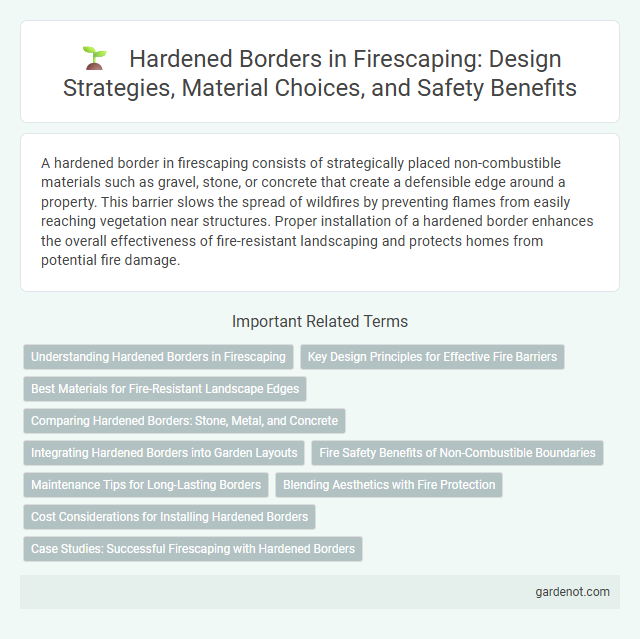A hardened border in firescaping consists of strategically placed non-combustible materials such as gravel, stone, or concrete that create a defensible edge around a property. This barrier slows the spread of wildfires by preventing flames from easily reaching vegetation near structures. Proper installation of a hardened border enhances the overall effectiveness of fire-resistant landscaping and protects homes from potential fire damage.
Understanding Hardened Borders in Firescaping
Hardened borders in firescaping are strategically designed zones that reduce wildfire risk by using fire-resistant materials and plants to create a defensible space around properties. These borders often incorporate non-flammable landscaping elements such as gravel, stone pathways, and drought-tolerant vegetation to slow or stop the spread of flames. Proper implementation of hardened borders significantly enhances property protection by minimizing combustible fuel near structures and enabling safer evacuation routes.
Key Design Principles for Effective Fire Barriers
Hardened borders in firescaping rely on non-combustible materials like stone, gravel, and concrete to create a continuous fire-resistant barrier that limits the spread of wildfire. The key design principles emphasize maintaining a minimum width of 3 to 5 feet for fuel reduction, incorporating moisture-retaining plants, and ensuring the barrier is free of debris and flammable vegetation. Proper layering with ember-resistant features and regular maintenance enhances the fire barrier's effectiveness in protecting structures and landscapes.
Best Materials for Fire-Resistant Landscape Edges
Hardened borders for fire-resistant landscape edges use materials like gravel, decomposed granite, and concrete pavers that create effective firebreaks by reducing combustible vegetation. Fire-resistant bricks and stone retain heat without igniting, providing a durable barrier between flammable plants and structures. Proper installation with compacted soil beneath further enhances the border's ability to prevent wildfire spread.
Comparing Hardened Borders: Stone, Metal, and Concrete
Stone hardened borders provide natural durability and aesthetic appeal, effectively resisting heat and fire while blending seamlessly into landscaping. Metal hardened borders offer superior strength and are highly resistant to warping and melting under high temperatures, making them ideal for intense fire-prone areas. Concrete hardened borders deliver exceptional fire resistance and longevity, serving as a robust barrier that prevents wildfire embers from encroaching on vulnerable vegetation and structures.
Integrating Hardened Borders into Garden Layouts
Integrating hardened borders into garden layouts enhances fire resistance by creating defensible spaces that slow the spread of flames. Using fire-resistant materials like stone, concrete, or gravel within these borders reduces combustible vegetation and provides effective barriers against radiant heat. Strategic placement around structures and pathways maximizes protection while maintaining aesthetic appeal and garden functionality.
Fire Safety Benefits of Non-Combustible Boundaries
Non-combustible hardened borders significantly enhance firescaping by acting as effective firebreaks that prevent the spread of flames and embers. Materials such as concrete, stone, or metal used in these boundaries withstand high temperatures and reduce ignition risks, safeguarding properties from wildfires. These durable barriers also help maintain defensible space, improving overall landscape fire safety and resilience.
Maintenance Tips for Long-Lasting Borders
Regularly inspect hardened borders for cracks or gaps to prevent weed intrusion and maintain structural integrity. Clean debris and buildup using a stiff brush or low-pressure water to preserve material durability. Apply a protective sealant annually to enhance resistance against weathering and extend the lifespan of the firescaping border.
Blending Aesthetics with Fire Protection
A hardened border in firescaping combines fire-resistant materials like gravel, stone, or concrete with native plants to create a natural-looking barrier that slows wildfire spread. This design not only enhances property safety by reducing combustible vegetation near structures but also maintains the visual appeal of the landscape. By integrating fire-resistant landscaping techniques, homeowners achieve effective fire protection without compromising garden aesthetics.
Cost Considerations for Installing Hardened Borders
Installing hardened borders for firescaping involves evaluating material costs such as concrete, stone, or metal edging, which vary significantly based on durability and aesthetic preferences. Labor expenses can increase depending on the complexity of terrain and the need for specialized installation techniques to ensure fire resistance. Factoring in long-term maintenance and potential replacement costs is crucial for budgeting a cost-effective, fire-resistant perimeter that enhances property protection.
Case Studies: Successful Firescaping with Hardened Borders
Case studies demonstrate that hardened borders, consisting of fire-resistant materials such as stone, gravel, and concrete, effectively reduce wildfire risk by creating non-combustible zones around properties. Properties utilizing these borders report lower incidences of fire damage, with documented cases in California and Australia showing enhanced containment of wildfires and improved protection of structures. Data highlights that the integration of hardened borders with strategic vegetation management significantly improves overall firescape resilience.
Hardened Border Infographic

 gardenot.com
gardenot.com